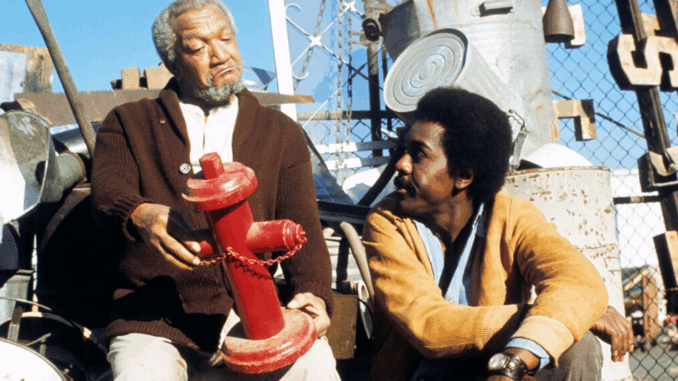
This Gay ‘Sanford and Son’ Episode Is One of TV’s First, and One of the Best
When we think about groundbreaking television of the 1970s, shows like All in the Family and M*A*S*H often dominate the conversation. But nestled within the comedic brilliance of Norman Lear’s Sanford and Son is one episode that quietly made history. It dealt with homosexuality—decades before queer characters became a standard part of television storytelling. This episode wasn’t just ahead of its time; it remains one of the funniest and most respectful early depictions of a gay character in mainstream television.
In an era when gay representation was often relegated to stereotypes, throwaway jokes, or outright invisibility, Sanford and Son managed to bring humor, humanity, and even a touch of progressiveness to primetime TV.
Setting the Stage: ‘Sanford and Son’ in the 1970s
Sanford and Son, which premiered on NBC in 1972, was an American adaptation of the British series Steptoe and Son. The sitcom followed Fred Sanford (Redd Foxx), a cantankerous junk dealer in Los Angeles, and his long-suffering son Lamont (Demond Wilson). With its mix of biting one-liners, slapstick, and cultural commentary, the show quickly became one of the most beloved sitcoms of its era.
The 1970s were also a turbulent time socially. The Stonewall riots had taken place only a few years before, sparking the modern LGBTQ+ rights movement. Despite growing activism, television networks were still cautious about addressing homosexuality directly. For a mainstream NBC sitcom to feature a gay character at all was rare—and to do it with comedy rather than cruelty was almost unheard of.
The Gay Episode: “Lamont, Is That You?”
The episode in question, titled “Lamont, Is That You?”, aired during the show’s first season in 1972. In it, Lamont befriends an openly gay man, leading Fred Sanford to jump to the wild conclusion that his son might also be gay.
Fred’s reaction is exactly what you’d expect from the sharp-tongued junk dealer: over-the-top, filled with dramatic one-liners, and dripping with the era’s slang. At first glance, his panic and prejudice reflect the discomfort many Americans still felt around homosexuality at the time.
But here’s the twist: the gay character is portrayed sympathetically and without ridicule. He’s not the butt of the joke—Fred is. The humor comes from Fred’s ignorance and exaggerated fear, not from mocking the gay man himself.
This approach made the episode stand out. Instead of reinforcing harmful stereotypes, it gently challenged them. It invited viewers to laugh at outdated attitudes rather than at gay identity itself.
Why This Episode Was Groundbreaking
-
One of the First Positive Portrayals
At a time when gay characters were often invisible or depicted negatively, Sanford and Son introduced a character who was comfortable with himself and not defined solely by his sexuality. -
The Joke Is on Prejudice, Not Identity
The episode cleverly subverted expectations. While Fred’s discomfort may have mirrored many viewers’ own biases, the writing directed laughter at those prejudices instead of legitimizing them. -
Cultural Conversation Starter
The mere inclusion of homosexuality in a primetime sitcom helped push the topic into American living rooms. For many viewers in 1972, this may have been their first exposure to a gay character treated with respect. -
Part of Norman Lear’s Legacy
Producer Norman Lear was known for weaving social issues into sitcoms. This episode of Sanford and Son added LGBTQ+ representation to his growing list of taboo topics tackled through comedy.
Audience Reception in the 1970s
Predictably, reactions to the episode were mixed. Some viewers praised it for daring to touch on a subject most shows avoided. Others complained, saying homosexuality had no place in primetime television.
But controversy aside, the episode was remembered as funny, thought-provoking, and surprisingly warm for its time. Even critics who were hesitant about its subject matter admitted that Redd Foxx’s comedic genius kept the storyline engaging and memorable.
Looking Back: How It Holds Up Today
Rewatching “Lamont, Is That You?” today is a fascinating experience. By modern standards, some of Fred’s language and assumptions feel dated, even uncomfortable. But the underlying message—that prejudice is absurd, and gay people deserve respect—still resonates.
In fact, the episode stands as a reminder that representation in media often starts small. What feels progressive in one decade may look quaint in another. Yet each of these steps builds on the last, creating the cultural momentum that allows for fuller, richer representation later.
Today, television features complex LGBTQ+ characters across genres, from comedies to dramas to superhero shows. But back in 1972, Sanford and Son helped lay some of that groundwork.
Why This Episode Still Matters
-
Historical Significance: It’s one of the earliest examples of a primetime sitcom dealing directly with homosexuality.
-
Cultural Commentary: It highlighted how irrational prejudice could be—using humor as a mirror.
-
Entertainment Value: Beyond its social impact, it’s simply a well-written, funny episode that shows Redd Foxx at the top of his comedic game.
-
Legacy for Representation: It opened the door, however slightly, for future shows to continue the conversation.
Conclusion: A Bold Step Forward in Sitcom History
“This Gay Sanford and Son episode” isn’t just a footnote in television history—it’s a reminder of how comedy can challenge social norms without losing its humor. By introducing an openly gay character in 1972 and directing the punchlines toward prejudice rather than identity, the show managed to be both hilarious and forward-thinking.
Nearly 50 years later, it remains one of the best early attempts at representation on network television. It paved the way for future LGBTQ+ characters, proving that sitcoms could tackle serious issues with heart, humor, and humanity.
Sanford and Son may have been about junk, but this particular episode was pure comedic treasure—and a cultural milestone that deserves to be remembered.
